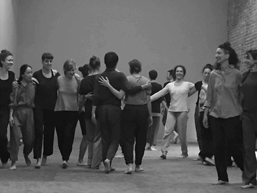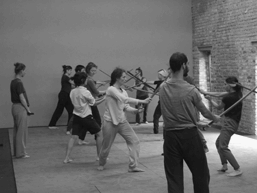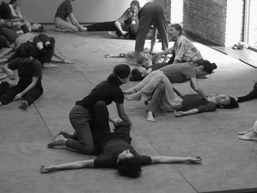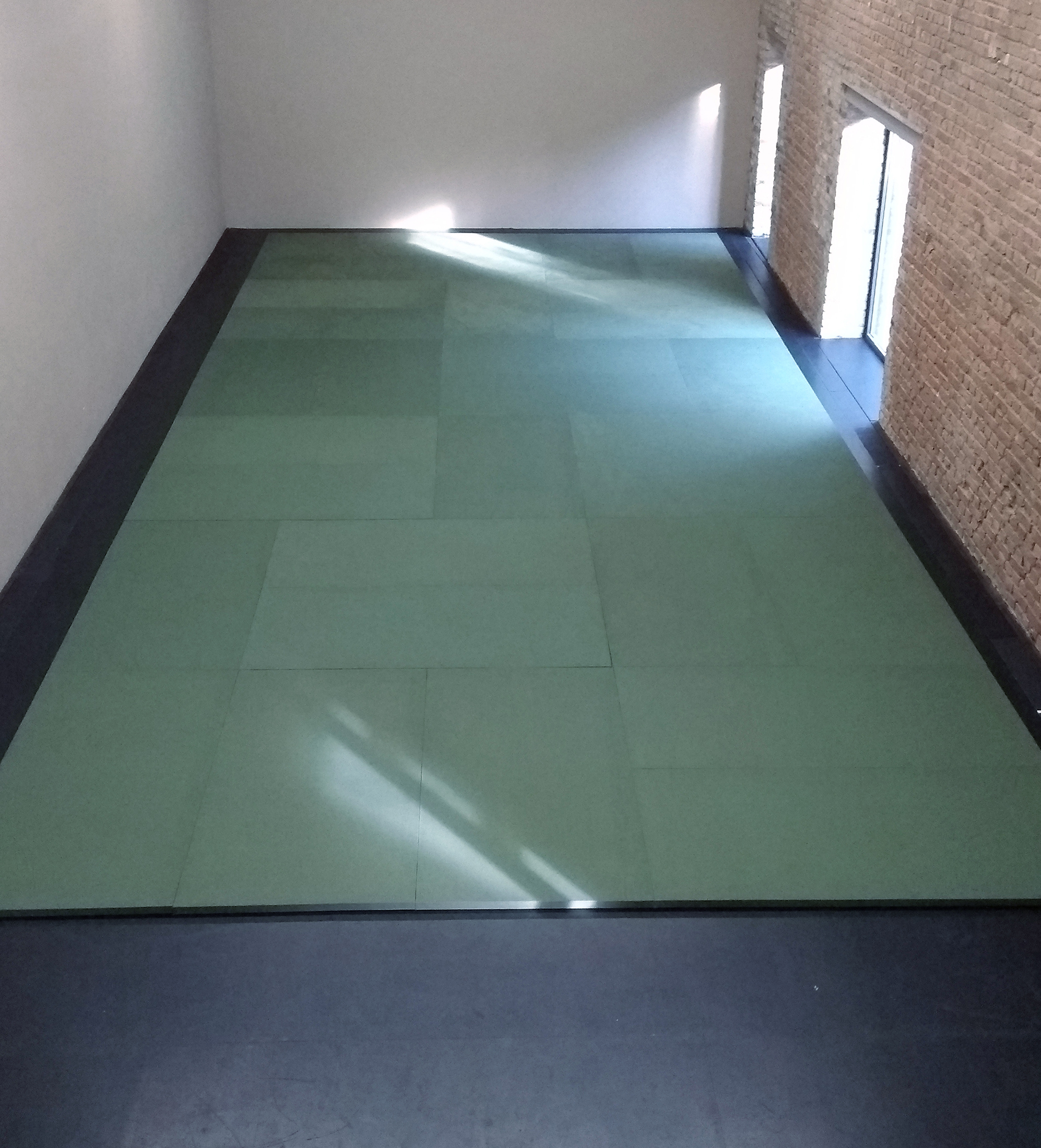The Open Practice Sessions have a history that goes back almost twenty years now. This platform is motivated by the desire to give the Open Practice Sessions a time and a space other than that of the rehearsal spaces where they usually take place. It is an experimental encounter between a physical practice, a dance practice – something that necessarily belongs to the dynamic sphere of doing, experiencing, sensing and moving – and the more clearly defined and delimited space of the blank page, an attempt to translate and transform a practice through and into language, words and signs. In that sense this is also a reflection on the relationship between a practice and the language that produces, transmits, affects and documents it.
Reflecting the collective nature of the Open Practice Sessions, the editorial concept of this platform is a polyphonic interweaving of various voices: mine and Isabelle Schad’s in this text, the testimonies of other guest contributors in the rest of the publication and some impressions left by the participants after the sessions (see the rolling texts at the top of the page). In the spirit of the Open Practice Sessions, the act of documenting is to be understood as open and dynamic and will in future be enriched with new visions, materials, contributions and languages.
13. August 2019
Dear all,
For some time now I’ve been interested in researching spaces of contemplation within a practice around energetic principles where time and attention are given to freeing the inner self from jumping thoughts, psychological issues or personal matters. If we feel free in ourselves and in our movements we can more easily become an organisation, an organism, sculpting energies and movements without any purpose beyond the work itself. The upcoming Open Practice Sessions focus on body work based on principles from Zen related practices such as Zen aikido, Zen meditation and shiatsu. The work concentrates on continuous movement; on breathing and Ki (energy); the unity of body and spirit; understanding weight shift and axis rotation; on cellular consciousness; on relating body parts and organs to one another and to our centre of gravity, in our individual work, in pairs and in our work together as a group. We will also do some energy work with swords, which we will learn to hold and move with.
Unlike the Open Practice Sessions I’ve done in the past, I would like to dedicate the full three hours to training and movement research as such, without any further goal of producing choreographic materials. If research ideas for further pieces do arise, it will be through observing what happens and allowing the essence of our being to unfold.
Please bring clothes in shades of grey, green, blue (no stripes, no logos, no prints). The visual connection between us will promote our work on togetherness. There will be tatami mats in the space, offering a soft ground.
The sessions will take place at Wiesenburg-Halle in Berlin Wedding, close to the Humboldthain. The two sessions will last around three hours each, from 16:00 to 19:00 on 26 and 27 August 2019. You can come for one or both days. The sessions are free. It would be great if you could help to clear the space after the second session. This should be very quick if we all work together 🙂
Please let me know if and when you would like to come so that I have an idea about the number of people to expect. Please contact me by email before 18 August at stantepede@gmail.com
Thanx a lot and warm greetings,
Isabelle
So how can a practice be documented? I asked myself this question while watching the most recent Open Practice Sessions, which were held at the Wiesenburg-Halle in Berlin in the late summer and autumn of 2019. The ontological friction and resistance that exists between dance and documentation seemed stronger than usual here, since the practice was not done to be seen or analysed; it was ‘practised’ for its own sake. The distance usually required to analyse things with any degree of objectivity didn’t seem entirely applicable. It felt paradoxical to write about this practice from a distance, without experiencing it, and so instead I consciously decided to put myself in the ambivalent position of being both inside and outside the practice, shifting between doing and documenting from a distance.
In both cases I became intrigued by language as a primary generator of the practice itself. While I was involved in the practice I was able to ‘feel’ the effect of language on my own body. While I was observing the practice I was able to visualize a progressive correspondence between the quality of the language and the body movements it engendered. Isabelle’s words accompany the Open Practice Sessions like a soft carpet of sound created by a sensitive, intuitive interweaving of pauses and silences that alternate with certain moments in which her guiding voice stimulates, triggers and suggests without directing or compelling.
Given the reciprocity of language and practice in the Open Practice Sessions, and thinking about the place where these two forms first met, it is necessary to take a step back from the dance floor and look for them in the emails that Isabelle sent out when she was inviting potential participants to join the sessions. It is here that the practice starts to crystallize and take shape, in the act of writing (and reading) these messages. These emails have been a feature of the Open Practice Sessions from the very beginning. They follow an almost ritualistic pattern. And while their content and focus may have changed over the years, they also reflect certain continuities and resonances.
Driven by a certain fascination with the founding myth of the Open Practice Sessions, I searched my email archive for the very first email I received from Isabelle.
11 April 2012
Dear all,
I’m happy to announce some more Saturday practice sessions, which I first ran at the Uferstudios a year ago. This time they’re at our new space at Wiesenburg, Wiesenstrasse 55, which we (Wiesen55 e.V. = a group of seven artists) renovated over the last few years. The sessions will be based on body practice (mainly around bmc / embryology) with some time for experimentation and research on ideas relating to my current work, which is concerned with notions such as:
an interest in looking into relationships between embryological processes and form, understanding foldings as transformation processes
an interest in looking into relationships between embryological processes and form, understanding foldings as transformation processes
pleasure in building those organisms out of a group experience (through practice)
crossing communities to become a community for the time spent together
a space for gathering and doing something together out of curiosity, learning desires, pleasure …
The proposal is open to all HZT students, alumni, friends and colleagues from our scenes (feel free to forward this mail). Since the initiative is in co-operation with HZT, it is suggested that participants bring coaching papers, which I would sign at the end of each session. People from outside HZT will be asked to pay what they can. The same would apply for alumni.
Each session will run from 10:00 to 13:00 at the Wiesenburg-Halle. I’m attaching a map and a description of how to find it. Please come a bit early if you’re coming for the first time so you can call me in case you can’t find it. But it should be quite easy if you follow the description. The whole Wiesenburg complex (an old shelter for the homeless) is private, so please come directly to the hall as indicated in the description.
It would be cool to know who would like to come, so please send me a short message.
Hope to be dancing with you soon.
Kisses,
Isabelle
Back in 2012, when this email was written, the Open Practice Sessions still weren’t called ‘open’ yet. But I think it was precisely this quality of openness ante litteram that motivated me as a non-dancer to get involved, to participate. This openness was expressed on several levels: in the sentence ‘feel free to forward’, for example – a verbal gesture of radical hospitality that demonstrated a readiness to welcome an unspecified number of known, lesser known and potentially unknown people into your home; and in the concept of ‘practice’ itself, ontologically vague and thus open to multiple interpretations and applications. In my position as a curator (at the time I was working with Isabelle on a dance festival in Italy) this open invitation presented itself as an opportunity to familiarise myself with her work from a new and unusual perspective, to see backstage of the creative process, to gain some insight into the making of her work, to witness not just by watching (which is what I was used to) but by doing and experiencing.
For me, being part of the Open Practice Sessions was and still is comparable to visiting the studio of a visual artist: it gives you an intimate encounter with the creative process, with the tools, the instruments and the raw materials, and at a point when everything’s still in a state of potentiality. Attending the Open Practice Sessions is a very special experience that’s quite unlike any other process-oriented format.
Unlike an open rehearsal, where the process – however open it might be – is already influenced and guided by the idea of some final performance and the ghost of a future audience, the Open Practice Sessions are not produced for an audience, they are not frontal. In this sense they’re closer to the idea of a collective training or a workshop, though they’re not really comparable to that either, because the pedagogical framework and the boundaries between teacher and taught are not so obvious or clearly defined in the Open Practice Sessions. They are a space for collective ‘experimentation and research’ in an emergent and contingent community. The (bodily) knowledge, the energy, the visual power of the group has always been a precious source of inspiration, creative input and aesthetic and social enrichment for Isabelle’s research on movement and choreography.
It was probably during this group research on dance and somatic practices at the very first Open Practice Sessions, announced in the email above and held at the Wiesenburg-Halle, that the pillars of Isabelle’s pioneering work at the interface of these two fields were established, that the introspective substance of somatics was transferred to the outside world, where its social and aesthetic potential could unfold. When I ask Isabelle to recall her motivation for initiating the Open Practice Sessions, she stresses this urge to share:
I guess I started the Open Practice Sessions as a continuation of what we wanted to instigate with Praticable: a way of learning by sharing body practices for their own sake and not in ways that were purely product orientated. When I search my website for the words we used to define our project I find this paragraph:
Praticable proposes a specific model of working together between artists in the field of dance and choreography: it is a horizontal work structure, based on the sharing of body practices, which brings together research, learning processes, creation, production and distribution, multiplying circulations between them. This structure is the basis for the creation of performances that are signed by one or more participants of the project. These performances are grounded, in one way or another, in the exploration of body practices to approach representation. Praticable was created in 2005 by Alice Chauchat, Frédéric de Carlo, Frédéric Gies, Isabelle Schad and Odile Seit.
After several years practicing together we lost the sense of togetherness we’d had in that specific constellation, and each of us then followed our own pathway and process. I felt a strong wish to continue with some ideas about sharing in body work and research. After doing it in the framework of my group project Musik (Praticable) at HZT/Uferstudios on Saturday mornings, when studio 11 was often free, I organised similar sessions at Wiesenburg, where we introduced our own working space, a ruin that we turned into a fully equipped space between 2006 and 2010, roughly.
I still remember my first Open Practice Sessions at heute: VOLKSTANZEN, a project where I’d wanted to start doing research in a more open format. After that I worked on the group project DER BAU, as far as I remember. Then came Collective Jumps. The sessions were always extremely popular and really packed; sometimes I had to ask people not to come on both days so that people could alternate and everyone could ‘fit in’.
The longevity and the vitality of the Open Practice Sessions lie in the convergence of different interests and motivations: first the desire among members of the Berlin dance community, and of young dancers in particular, to meet Isabelle – a well-known choreographer who’d managed to make it on the tortuous paths of the independent dance scene – and get to know her work in an informal and familiar atmosphere. Then Isabelle’s own interest in using the Open Practice Sessions as a basis for research, for experimenting with new ideas and as a place for meeting new people and bodies, in ever new forms and constellations.
The Open Practice Sessions respond to a circular and autopoietic understanding of knowledge transmission, to the idea that new knowledge is produced and assimilated in the very process of transmitting knowledge. Interestingly, when I asked Isabelle how the Open Practice Sessions had developed over the years, she identified a significant recent change in the core meaning of this transmission:
I guess until the work Pieces and Elements the sessions were mostly connected to new productions or works, and for that I’d wanted to start a piece of research that would be open to the dance community. It was also a way of meeting and connecting with people. Basically I’d been waiting for people to find me, or the type of work I share, as a way to avoid auditions, which I never liked doing, in either role. After a while it became known in the scene that this was a way to meet me, and obviously many people still came with the idea of an ‘audition’ in mind, almost as though they were hidden auditions, which was right and wrong at the same time. Right because it was true; I was often looking for people. This was the case with VOLKSTANZEN or DER BAU for example. And wrong because that was not how I wanted those sessions to feel at all.
At the beginning of each session I would point out that I didn’t want it to feel like an audition, but it was really hard to stop that happening. In the last couple of years I’ve been trying to change that drastically. Separating the Open Practice Sessions from the production periods was crucial in order to be able to stick to the work itself and its essence. I think the failure of an application helped with this process: I was planning to do an Open Practice Session in the context of the next group work Reflection, then the HKF application failed. The Open Practice Sessions were happening anyway and it was very healthy to know there was no way to connect with anyone else other than by being there, because I had no ‘jobs’ to give to anyone. Now I’m really glad that the Open Practice Sessions changed and became even more special to everyone. It’s a much purer way of sharing the work, as training and practice, as things that we try out and as meetings on a human level.
Looking at the notes I made during the most recent Open Practice Sessions I find the phrase ‘practising with tranquillity’ and I recall that that was the prevailing feeling I sensed in the Wiesenburg-Halle on that occasion. The progressive process of being liberated from production mechanisms, from pressure and from the sense of the ‘hidden audition’ that Isabelle describes must be one reason for it. To do away with this conditioning is to eradicate the practice in the present moment and, at least partially, to participate in a way that goes beyond the specific roles that the ‘scene’ tends to give us, whether it’s choreographer, dancer, curator, dramaturg or performer.
The idea of being present in the moment is one of the pillars of meditation, and in recent times Isabelle’s research seems to have been more strongly motivated by an existential, almost spiritual urgency that penetrates her artistic research from a human and personal sphere. An intense practice of aikido, Zen and shiatsu in recent years has contributed a great deal to this shift. Movement principles from aikido concerning the shifting of weight in relation to gravity have been imported into her choreographic work and have become an important pillar in her research on movement. Precision, contemplative repetition, minimalism and simplicity are affiliated concepts that have come together with an understanding of technique as something far from mere formal execution. It seems that technique can only be fulfilled through the activation of an energy that comes from an inner attitude, from a deeper listening to and understanding of the body.
During the most recent Open Practice Sessions some time was spent learning how to hold swords and give each other massages according to shiatsu principles. While these exercises were being performed, and in order to evoke a certain quality of movement, Isabelle insisted on the word ‘coherence’ as something that appears
when it’s ‘right’ for someone, meaning not right or wrong in the intellectual sense, but when the movement or presence is most truthful and therefore also ‘true’ or ‘right’ in relation to the forces that exist. On our planet that force is gravity. The weight shift has a push–pull relationship. There is always one side of the body pushing, the other one pulling. These forces need to be understood and re-examined, but at the same time they’re the most ‘natural’ ones because they’re the ones that have to do with gravity.
This fascinating and perhaps utopian research on the essence of movement implies a concentrated and patient but also joyful and relaxed way of being with ourselves and others. This is what the Open Practice Sessions are about. They provide a protected and yet wide open space for practising with tranquillity.
Elena Basteri is a dance curator, writer and dramaturge based in Berlin.



